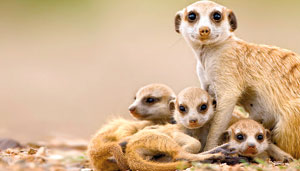There’s a reason a group of
meerkats are called a gang –
these little animals love to hang out
together. Meerkats are the most social of all the mongooses. They’re
playful and spend hours grooming each other, snacking on any ticks they pick off their friends. Gangs (also known as clans or mobs) of meerkats can number up to 50, but most are made up of about 20 members.
Burrowing into the loose desert sands, meerkats construct
wonderfully elaborate burrow
systems in which many ‘rooms’ are linked by tunnels. Some have been found with upto 70 exits! It means a group of meerkats can forage safely for food – the slightest hint of danger and they all head for the nearest bolt hole, disappearing into the earth.
Meerkats build many dens and like to move house every few days. The only time a meerkat clan will stay in the same burrow for three weeks is when the alpha female is about to give birth. At the head of the clan are an alpha male and alpha female.
Technically, these are the only mating pair in each clan. The rest are either siblings or children of the alpha pair.
The alpha female is usually the
largest in the clan, and she will viciously attack the pups of any beta females who try to breed. Once her young are born, this mother appears to lose interest in them – instead her meerkat family takes over.
Any female meerkats that can
produce milk will feed the young and the adults all share their food with the pups.
Pups that make the loudest ‘begging’ sounds get fed the most.
A ‘babysitter’, who can be either male or female, will look after the young ones while the others are out foraging. Even more fascinating, is the system of mentoring. Here an older meerkat will choose a younger meerkat and teach him or her how to do things like forage for food, spot predators and dig a burrow.
Meerkats are among the only
animals known to pass down ‘traditions’ such as ‘ family alarm’ through successive generations.
If you were sitting in the grass with a clan of meerkats around you, it’s likely all you’d see would be the black tips of their tails. An individual
meerkat need only stand up on her hind legs to spot the rest of her clan (an adult meerkat is typically
12 inches tall and weighs less than
a kilogram).
However, meerkats
actually rely on scent rather than sight to identify their family – they lovingly coat each other in spit and secretions from their anal glands each night just for this purpose.
Meerkats can be found all over the Kalahari Desert in Botswana and in the savannas and
grasslands of South Africa, Namibia and Angola, in other deserts in Africa like the Namib.
They’ve evolved to
survive in this
habitat and to be expert burrowers. A clear protective membrane shields their eyes from dirt while they dig and their ears close to keep the dirt out. Black bands around their eyes help protect them from the harsh glare of the sun – a sentry will be able to see that predatory bird
coming a long way off.
Sentry duty is a great
responsibility for a meerkat – he or she has to stand guard while the rest of the clan looks for food or simply lazes around. Standing on his or her hind legs, a tail propping the body up, a sentry must stay constantly alert.
At the sound of the sentry’s
warning bark, the rest will drop
whatever they’re doing to sprint for their burrows. The sentry is also the first one to come back out, to check if the coast is clear.
Pups are fed and cared for by the entire family until finally, after
10 months, a few are ready to go found gangs of their own. However, many will stay with their clan for as long as three years, nearly a quarter of their lifespan. |


